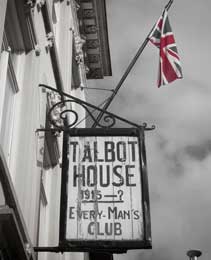
If you have walked past the Toc H hall in Royal Tunbridge Wells and wondered, this may solve the matter. The name is an abbreviation for Talbot House, ‘Toc’ signifying the letter T in the Signals spelling alphabet used by the British Army in World War I. 100 years ago on the Western Front, army padre Philip “Tubby” Clayton and his colleague padre Neville Talbot recognised the urgent need for a soldiers’ club where the troops could meet to relax and recuperate when behind the lines. A two storey house in Poperinge (“Pop”) was procured and named after Talbot’s brother, Gilbert, who was killed at Ypres on 30 July, aged 23. Talbot House was known as the Every-Man’s Club; in this house rank was irrelevant, orders were prohibited, and all soldiers were encouraged to forget about the war.
The top floor became a chapel, using a carpenter’s bench for an altar. Tubby estimated over 100,000 attended there during the war, whether for public service or private prayer.
The ground floor was a lounge, library and tea room. Alcohol was not served.
It was an instant success and continued until the immediate area became too dangerous, after which Talbot House went mobile using prefabricated wooden sheds. The original Talbot House exists to this day as a museum.
Back in London in 1920, Clayton founded a Christian youth centre in London, also called Toc H, which developed into an interdenominational association for Christian social service. Clayton became the Vicar of All Hallows by the Tower (of London) for some 40 years.
Talbot House is celebrated at a new exhibition at the Guildhall Library in London. It comprises displays of contemporary objects including pages of Tubby Clayton’s letters, notes and diaries. The hut in the middle of the display is an actual survival: not a replica.
Talbot House: An Oasis in a World Gone Crazy runs until 8 January 2016. Entry is free.

You must be logged in to post a comment.